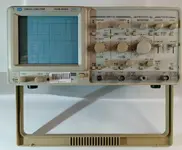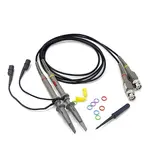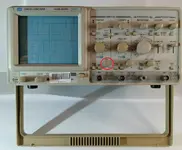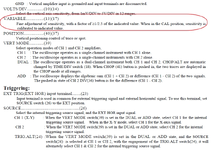famous beagle
Well-known member
Hey y'all,
So I just bought my first hardware oscilloscope off ebay. It's mainly just a curiosity, although I would like to make use of it with regard to calibrating tape machines (azimuth, etc.) eventually.
However, it arrived slightly damaged -- the handle is broken. The seller told me he can send me another handle, but before I do that, I wanted to verify that it was still functional.
Since I've never used one before at all, I was wondering if someone could instruct me on a very basic setup I could use to check basic functionality. I know I won't be able to completely put it through its paces, but I want to make sure it's not a dead stick at the very least.
Attached are the scope and probes I have.
Could someone possibly give me a very quick explanation on how I could quickly just make sure it's actually "oscilloscoping" the way it's supposed to be? It doesn't have to have anything to do with tape machines, music, or anything --- just whatever is quick and easy for a newbie like me (assuming that's possible).
Thanks!
So I just bought my first hardware oscilloscope off ebay. It's mainly just a curiosity, although I would like to make use of it with regard to calibrating tape machines (azimuth, etc.) eventually.
However, it arrived slightly damaged -- the handle is broken. The seller told me he can send me another handle, but before I do that, I wanted to verify that it was still functional.
Since I've never used one before at all, I was wondering if someone could instruct me on a very basic setup I could use to check basic functionality. I know I won't be able to completely put it through its paces, but I want to make sure it's not a dead stick at the very least.
Attached are the scope and probes I have.
Could someone possibly give me a very quick explanation on how I could quickly just make sure it's actually "oscilloscoping" the way it's supposed to be? It doesn't have to have anything to do with tape machines, music, or anything --- just whatever is quick and easy for a newbie like me (assuming that's possible).
Thanks!





